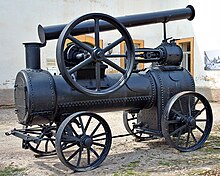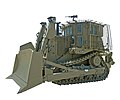
A military engineering vehicle is a vehicle built for construction work or for the transportation of combat engineers on the battlefield. These vehicles may be modified civilian equipment or purpose-built military vehicles. The first appearance of such vehicles coincided with the appearance of the first tanks, these vehicles were modified Mark V tanks for bridging and mine clearance. Modern military engineering vehicles are expected to fulfill numerous roles, as such they undertake numerous forms, examples of roles include; bulldozers, cranes, graders, excavators, dump trucks, breaching vehicles, bridging vehicles, military ferries, amphibious crossing vehicles, and combat engineer section carriers.

A tractor is an engineering vehicle specifically designed to deliver a high tractive effort at slow speeds, for the purposes of hauling a trailer or machinery such as that used in agriculture, mining or construction. Most commonly, the term is used to describe a farm vehicle that provides the power and traction to mechanize agricultural tasks, especially tillage, and now many more. Agricultural implements may be towed behind or mounted on the tractor, and the tractor may also provide a source of power if the implement is mechanised.

A skid loader, skid-steer loader, SSL, or skidsteer is any of a class of compact heavy equipment with lift arms that can attach to a wide variety of buckets and other labor-saving tools or attachments.

Excavators are heavy construction equipment primarily consisting of a boom, dipper, bucket and cab on a rotating platform known as the "house" - although the largest form ever, the dragline excavator, eliminated the dipper in favor of a line and winch.

A bulldozer or dozer is a large, motorized machine equipped with a metal blade to the front for pushing material: soil, sand, snow, rubble, or rock during construction work. It travels most commonly on continuous tracks, though specialized models riding on large off-road tires are also produced. Its most popular accessory is a ripper, a large hook-like device mounted singly or in multiples in the rear to loosen dense materials.
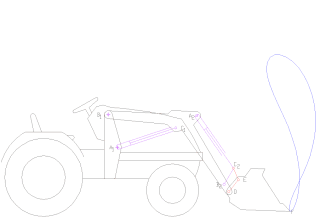
A loader is a heavy equipment machine used in construction to move or load materials such as soil, rock, sand, demolition debris, etc. into or onto another type of machinery.

A backhoe—also called rear actor or back actor—is a type of excavating equipment, or digger, consisting of a digging bucket on the end of a two-part articulated arm. It is typically mounted on the back of a tractor or front loader, the latter forming a "backhoe loader". The section of the arm closest to the vehicle is known as the boom, while the section that carries the bucket is known as the dipper, both terms derived from steam shovels. The boom, which is the long piece of the backhoe arm attached to the tractor through a pivot called the king-post, is located closest to the cab. It allows the arm to pivot left and right, typically through a range of 180 to 200 degrees, and also enables lifting and lowering movements.
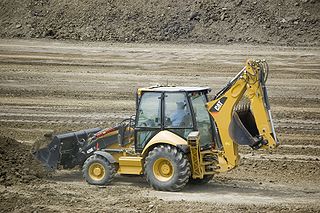
A backhoe loader, also called a loader backhoe, loader excavator, tractor excavator, digger or colloquially shortened to backhoe within the industry, is a heavy equipment vehicle that consists of a tractor-like unit fitted with a loader-style shovel/bucket on the front and a backhoe on the back. Due to its (relatively) small size and versatility, backhoe loaders are very common in urban engineering and small construction projects as well as developing countries. This type of machine is similar to and derived from what is now known as a TLB (Tractor-Loader-Backhoe), which is to say, an agricultural tractor fitted with a front loader and rear backhoe attachment.

A grader, also commonly referred to as a road grader, motor grader, or simply blade, is a form of heavy equipment with a long blade used to create a flat surface during grading. Although the earliest models were towed behind horses, and later tractors, most modern graders are self-propelled and thus technically "motor graders".

In civil engineering, a wheel tractor-scraper is a type of heavy equipment used for earthmoving. It has a pan/hopper for loading and carrying material. The pan has a tapered horizontal front cutting edge that cuts into the soil like a carpenter's plane or cheese slicer and fills the hopper which has a movable ejection system. The horsepower of the machine, depth of the cut, type of material, and slope of the cut area affect how quickly the pan is filled.

Case Construction Equipment is an Italian manufacturer of construction machinery. Along with CASE IH, Case Construction Equipment is a brand of CNH. Case produces construction equipment including excavators, motor graders, wheel loaders, vibratory compaction rollers, crawler dozers, skid steers, and compact track loaders.

BEML Limited, formerly Bharat Earth Movers Limited, is an Indian public sector undertaking which manufactures a variety of heavy equipment, such as that used for earth moving, railways, transport and mining. It is headquartered in Bangalore. BEML is Asia's second-largest manufacturer of earth moving equipment. Its stock trades on the National Stock Exchange of India under the symbol "BEML", and on the Bombay Stock Exchange under the code "500048".

Mighty Machines is a Canadian educational children's television series that teaches about machines and how they work. The show premiered in 1994 airing 39 episodes over three seasons until 2008.

A compact or mini excavator is a tracked or wheeled vehicle with an approximate operating weight from 0.7 to 8.5 tonnes. It generally includes a standard backfill blade and features independent boom swing.

The Euclid Company of Ohio was a manufacturer which specialized in heavy equipment for earthmoving, particularly dump trucks, loaders and wheel tractor-scrapers. It operated in the US from the 1920s to the 1950s, when it was purchased by General Motors. The firm was later bought by Hitachi Construction Machinery.
A bucket is a specialized container attached to a machine, as compared to a bucket adapted for manual use by a human being. It is a bulk material handling component.
GPS when applied in the earthmoving industry can be a viable asset to contractors and increase the overall efficiency of the job. Since GPS satellite positioning information is free to the public, it allows for everyone to take advantage of its uses. Heavy equipment manufacturers, in conjunction with GPS guidance system manufacturers, have been co-developing GPS guidance systems for heavy equipment since the late 1990s. These systems allow the equipment operator to use GPS position data to make decisions based on actual grade and design features. Some heavy equipment guidance systems can even operate the machine's implements automatically from a set design that was created for the particular jobsite. GPS guidance systems can have tolerances as small as two to three centimeters making them extremely accurate compared to relying on the operator's skill level. Since the machine's GPS system has the ability to know when it is off the design grade, this can reduce surveying and material costs required for a specific job.

Fiatallis, was a brand of heavy equipment, such as loaders, bulldozers, backhoes, scrapers, and graders. It began in January 1974, when Allis-Chalmers's construction equipment business was reorganized into a joint venture with Fiat SpA, which bought a 65% majority stake at the outset.
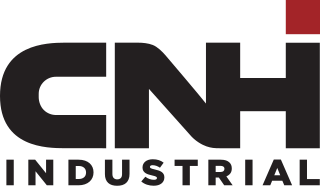
CNH Industrial N.V. is an Italian-American multinational corporation with global headquarters in Basildon, United Kingdom, but controlled and mostly owned by the multinational investment company Exor, which in turn is controlled by the Agnelli family. The company is listed on the New York Stock Exchange. The company is incorporated in the Netherlands. The seat of the company is in Amsterdam, Netherlands, with a principal office in London, England.
Associated Training Services, commonly known as ATS is a heavy equipment training institution based in Sun Prairie, Wisconsin. It was founded in 1959 by Robert Klabacka as the National Institute of Concrete Construction. The institute offers training programs in heavy equipment, mobile cranes, construction-related trucks, rigging, signaling, and commercial motor vehicles. ATS is one of the oldest training institution in United States of America has been an accredited sponsor providing accredited crane operator certification through the National Center for Construction Education and Research (NCCER), in Alachua, Florida since 2003, and the National Commission for the Certification of Crane Operators (NCCCO)



